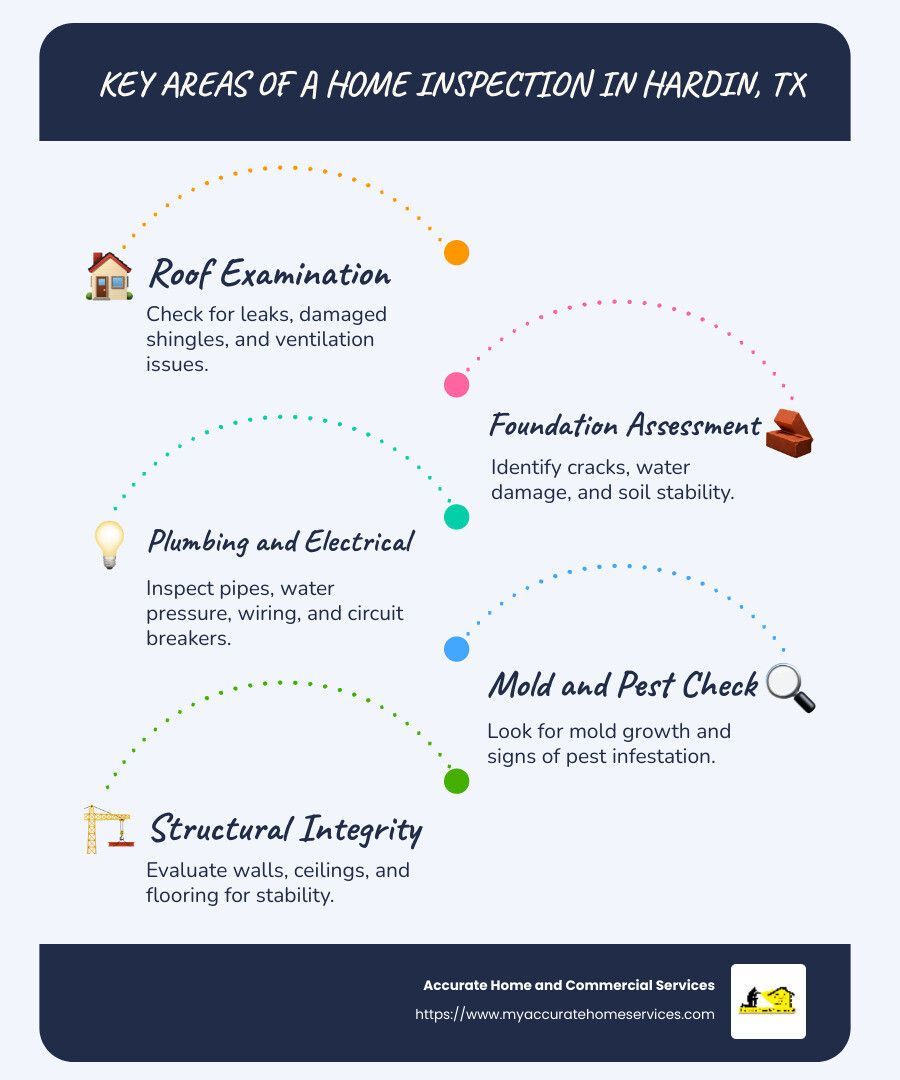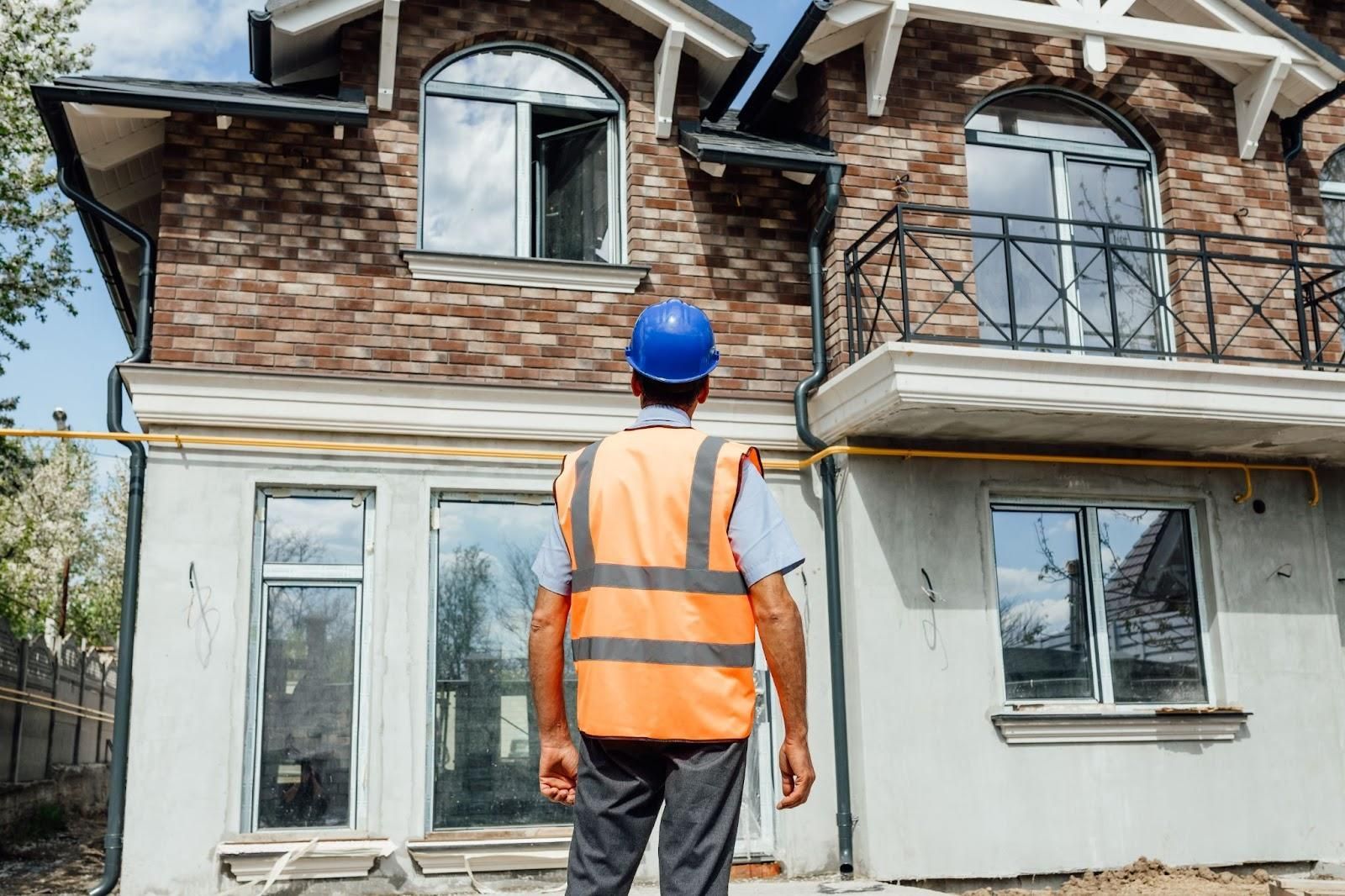Unlocking the Secrets of Home Inspections in Hardin, TX
Home inspection is vital for ensuring the safety and well-being of both homeowners and prospective buyers. Given the area's unique environmental challenges, inspections deliver insights that help maintain property value and prevent costly repairs. These evaluations cover everything from structural integrity to potential mold and pest issues, striving to identify any hidden threats to property safety.
Quick answers for those searching for immediate insights include:
- Purpose: Identifying safety issues, maintenance needs, and potential dangers.
- Common Findings: Roof leaks, foundation cracks, plumbing issues, and electrical concerns.
- Benefits: Provides peace of mind, aids in transactions, and prevents future costly repairs.
Homeowners and buyers should prioritize regular inspections to protect their investments and ensure a safe living environment.

Understanding Home Inspections
When it comes to home inspection, understanding the inspection process is crucial. It's like a health check-up for your home. Inspectors assess the property from top to bottom to ensure everything is in good shape.
The Inspection Process
The inspection process is thorough and detailed. Inspectors look at various aspects of the home to identify any issues. They start with a visual examination of the property, checking for any obvious problems like cracks or leaks.
Next, they move on to test major systems such as plumbing, electrical, and HVAC. These systems are vital for a home's functionality and safety. If something's wrong, it can lead to bigger problems down the line.
Structural Evaluation
Structural evaluation is a key part of any home inspection. Inspectors examine the foundation, walls, and roof to ensure they are sound and stable. Foundation cracks or roof leaks can indicate serious issues that need immediate attention.
A good inspector will also check the windows and doors. These are often overlooked but are essential for energy efficiency and security.
Major Systems
Inspectors don't just look at the surface. They dig deeper into the major systems of the house. This includes:
- Plumbing: Checking for leaks, water pressure, and proper drainage.
- Electrical: Ensuring wiring is safe and up to code.
- HVAC: Making sure heating and cooling systems are working well.
By understanding these elements, homeowners and buyers can make informed decisions. Regular inspections help prevent unexpected repairs and maintain property value.
A home inspection is not just a formality. It's an essential step in safeguarding your investment and ensuring a safe living environment for you and your family.
Home Inspection in Hardin TX: What to Expect
When you're gearing up for a home inspection in Hardin, TX, it's important to know what types of inspections are on the table. Understanding these can help you spot potential issues before they become costly problems.
Thermal Inspections
Thermal inspections use infrared cameras to detect things the naked eye might miss. This includes:
- Moisture Intrusion: Identifying leaks in roofs or walls that could lead to water damage.
- Heat Loss: Spotting areas where your home is losing heat, which can increase energy bills.
- Electrical Hotspots: Finding overheated wires that might pose a fire risk.
Thermal inspections are like having x-ray vision for your home. They reveal hidden problems that could affect your comfort and safety.
Pest Inspections
Pests can wreak havoc on a home's structure. A comprehensive pest inspection checks for signs of:
- Termites and Wood-Destroying Insects: These critters can cause significant structural damage if not detected early.
- Rodents and Other Pests: Mice, rats, and other pests can lead to health issues and property damage.
Spotting these issues early can save you from expensive repairs and health risks down the line.
Mold Testing
Mold is more than just an eyesore. It can pose serious health risks, especially for those with allergies or asthma. Mold testing involves:
- Visual Inspection: Looking for visible signs of mold growth.
- Air Quality Testing: Detecting hidden mold spores in the air.
Mold testing is crucial in humid areas like Hardin, TX, where moisture can easily lead to mold growth. Identifying and addressing mold early ensures a healthier living environment.
By knowing what to expect from a home inspection in Hardin, TX, you can better prepare and protect your investment. These inspections not only help you understand the current state of a property but also give you peace of mind.
Common Red Flags in Home Inspections
When buying a home, it's crucial to be aware of potential red flags that could indicate underlying issues. Identifying these problems during a home inspection in Hardin, TX can save you money and stress in the long run.
Roof Issues
Roof problems are a major concern in home inspections. Common signs include:
- Missing or Damaged Shingles: These can lead to leaks and water damage.
- Sagging Rooflines: This could indicate structural issues.
- Moss or Algae Growth: While sometimes just cosmetic, it can also signal moisture problems.
A thorough roof inspection can reveal these issues early, allowing you to address them before they escalate.
Foundation Problems
The foundation is the backbone of your home. Foundation issues can be serious and expensive to fix. Look for:
- Cracks in Walls or Floors: These might suggest shifting or settling.
- Doors and Windows that Stick: This can indicate movement in the foundation.
- Water in the Basement or Crawl Space: Moisture intrusion can weaken the foundation over time.
A solid foundation is key to a home's safety and value. Spotting these signs early can prevent costly repairs.
Window and Door Concerns
Windows and doors are not just for aesthetics; they also play a role in your home's energy efficiency and security. Common problems include:
- Drafts: Poor sealing can lead to energy loss.
- Difficulty Opening or Closing: This might suggest warping or foundation issues.
- Condensation Between Panes: This indicates a broken seal in double-paned windows.
Addressing these concerns can improve your home's comfort and reduce energy costs.
Recognizing these red flags during a home inspection can help you make informed decisions about your property. Whether it's negotiating repairs or planning for future maintenance, understanding these issues is crucial for any homeowner.
The Importance of Mold and Pest Inspections
Mold and pests can silently wreak havoc on a home, making mold and pest inspections critical for anyone considering a home inspection in Hardin, TX.
Mold Risks
Mold thrives in humid environments, and it can spread quickly, damaging your home's structure and belongings. More importantly, mold poses health risks, especially to those with allergies or asthma. Common symptoms include sneezing, coughing, and even more severe respiratory issues.
Early detection is vital. Professional mold inspections use advanced technology to identify mold presence, even in hidden areas. This allows homeowners to take action before mold becomes a larger problem.
Pest Control
Pests like termites and rodents are more than just a nuisance. Termites, for instance, can cause significant structural damage, often going unnoticed until it's too late. Rodents can chew through wiring and spread diseases.
A comprehensive pest inspection identifies these threats early. This can save homeowners from expensive repairs and potential health issues. Pest control measures, when implemented promptly, can prevent infestations from escalating.
Health Implications
Both mold and pests can negatively impact health, particularly for vulnerable individuals such as children and the elderly. Mold exposure can lead to chronic health issues, while pests can introduce allergens and pathogens into the home.
Ensuring your home is free from mold and pests is essential for a safe living environment. Regular inspections can provide peace of mind and protect both your property and your health.
Frequently Asked Questions about Home Inspections
How much does a home inspection cost in Texas?
The cost of a home inspection in Texas can vary, but on average, expect to pay between $300 and $500. The price often depends on the size and age of the home. Larger homes require more time to inspect, which can increase costs. Some inspections might also include additional services like mold testing or pest inspections, which can add to the overall expense.
What are the biggest red flags in a home inspection?
Certain issues can be major red flags during a home inspection. Roof problems are a big concern. Leaks or missing shingles can lead to water damage inside the home. Foundation issues are another red flag. Cracks or uneven settling can indicate serious structural problems. Windows and doors that don't open or close properly might suggest poor installation or shifting foundations. These issues often require significant repairs, impacting the home's safety and value.
Is it worth paying for a home inspection?
Absolutely, investing in a home inspection is a smart move. It serves as a powerful negotiation tool. Finding issues before buying can help you negotiate a better price or request repairs. Inspections can lead to significant savings by preventing costly surprises down the road. Identifying problems early allows homeowners to address them before they escalate, thus ensuring the home's longevity and safety.
Conclusion
Choosing Accurate Home and Commercial Services for your home inspection in Hardin, TX ensures a thorough and reliable evaluation of your property. Their commitment to customer satisfaction is evident in their attention to detail and comprehensive inspection services. With years of experience in the Greater Houston area, they have built a reputation for providing peace of mind to homeowners and buyers alike.
Accurate Home and Commercial Services offers a wide range of inspection options, including thermal imaging, pest inspections, and mold testing. Their full-service approach means you get a complete picture of your property's condition, helping you make informed decisions. This dedication to thoroughness not only protects your investment but also improves the safety and value of your home.
For those navigating the complexities of homeownership, a reliable inspection service is invaluable. By choosing Accurate Home and Commercial Services, you are partnering with experts who prioritize your needs and the safety of your property.
For more details on their services, visit Accurate Home and Commercial Services.











